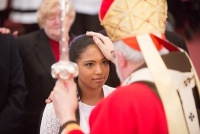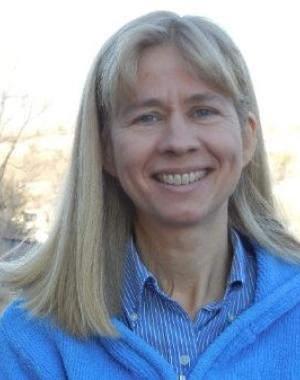 Born into a Catholic family and baptized when I was sixteen days old, I grew up accepting the Church, receiving from her, but not understanding much about her identity. True, I appreciated the beauty in the stained-glass windows and the rich wood of the pews of my parish church. And in Holy Communion at a young age, I remember on occasion experiencing deep peace and comfort. I also felt a sense of awe, of a holy presence, when I entered the chapels of the Catholic schools I attended. Never in my years of Catholic school (during the 70’s and 80’s) did I learn what “One, Holy, Catholic and Apostolic” meant. After four years at a liberal Catholic university, I pursued a degree in philosophy at a secular state university. The Newman center where I sought refuge was dominated by a group of people who were skeptical of the Church’s teachings, especially on moral issues. They viewed the Church primarily as an institution, as old-fashioned, and the hierarchy as out of touch. Many were what would be termed “cultural Catholics,” and not evangelized. At first, I sympathized with their ideas. The cardinals holding offices in the Vatican, especially Cardinal Ratzinger, did seem too strict. I could not see why women could not become priests. I merrily went along with the chaplain at the center who asked me to develop a format for evening prayer and lead it. (He never mentioned that such a thing already existed in the Church, the centuries-old Liturgy of the Hours.)
Born into a Catholic family and baptized when I was sixteen days old, I grew up accepting the Church, receiving from her, but not understanding much about her identity. True, I appreciated the beauty in the stained-glass windows and the rich wood of the pews of my parish church. And in Holy Communion at a young age, I remember on occasion experiencing deep peace and comfort. I also felt a sense of awe, of a holy presence, when I entered the chapels of the Catholic schools I attended. Never in my years of Catholic school (during the 70’s and 80’s) did I learn what “One, Holy, Catholic and Apostolic” meant. After four years at a liberal Catholic university, I pursued a degree in philosophy at a secular state university. The Newman center where I sought refuge was dominated by a group of people who were skeptical of the Church’s teachings, especially on moral issues. They viewed the Church primarily as an institution, as old-fashioned, and the hierarchy as out of touch. Many were what would be termed “cultural Catholics,” and not evangelized. At first, I sympathized with their ideas. The cardinals holding offices in the Vatican, especially Cardinal Ratzinger, did seem too strict. I could not see why women could not become priests. I merrily went along with the chaplain at the center who asked me to develop a format for evening prayer and lead it. (He never mentioned that such a thing already existed in the Church, the centuries-old Liturgy of the Hours.)
About this time, I discovered the works of a great twentieth-century theologian, Hans Urs von Balthasar. As I read, I began to see sense in the Church’s teachings, and even to challenge my fellow Catholics on their views. After completing my master's in philosophy, I moved to Switzerland to study von Balthasar’s work at the University of Fribourg.
Breathing Rich Catholic Air
The theology department at the university was well known and attracted students from all over the world, especially Europe, but also central and south America and Africa, as well as a few Americans. Many were young men preparing to be priests or religious, and others were lay men and women preparing to teach or do other ministry. Fribourg was a little, medieval town of forty thousand people, containing at least twenty convents and monasteries. Catholic orders had fled there during the Reformation, and many orders had established houses of study there. There were also a few branches of lay communities, some living together in households. The Church there was teeming with life. I went to Mass one day with the Carmelite brothers from France—their liturgy was full of silence, no singing, beautiful in its stark simplicity—and the next day with the Swiss Dominican community, known for their preaching and rich liturgical music. Then I went to the Little Brothers and Sisters of Jesus, a community of humble, simple men and women who labored with the poor. I made private retreats in the twelfth-century Cistercian women’s monastery where the Mass and the Liturgy of the Hours were chanted in Latin. I lived with other students from an Italian lay group whose charism was friendship and the transformation of culture. I began to see that all of these were equally Catholic—so diverse, and yet one: they all believed the same things and worshiped at the same liturgy, just in different languages and styles. I sensed a special bond between us far greater than our differences. We were caught up in the same mystery: Christ and his Church.
I discovered the writings of the saints, meditated on them in my prayer, and celebrated their feast days, as well as the whole liturgical year. I took part in processions with the Holy Eucharist through the city streets on Corpus Christi, with the town band and the city mayor leading the way. I spent the Holy Triduum in the Cistercian monastery, my heart aching at the beauty of the chants, the silence, and the Romanesque stone arches.
Long before I began to study the doctrines concerning the Church, I was experiencing the richness of her reality. I looked at her now with reverence and awe. I had a sense of being indebted to the Church, a storehouse of treasures—the thousands of examples of holy men and women, all the millions of pages of writings, all kinds of spiritualities, and so many ways of praying and serving to suit all types of people.
The Doctrine Behind It All
As part of my licentiate program in theology, I took a yearlong course in Ecclesiology, which is the study of the Church. That class only confirmed and deepened what I was discovering outside the classroom. We pored over the Scripture passages that referred to the Church, we read how these truths were understood by the Fathers of the Church, and we watched the Church’s understanding of herself grow as she moved through history. The documents of the Second Vatican Council, Lumen Gentium in particular, amplified and elucidated our understanding of the Church’s identity. I saw that the Church is a multi-faceted jewel: at once People of God, Body of Christ, Bride of Christ, Communion, universal, hierarchical. Above all, I came to see that the Church is a mystery, indissolubly united to that of her Bridegroom.
Finally, I understood that the hierarchy, far from being a mere disciplinarian, is meant to be a safeguard—her leaders, acting in accord with the Holy Spirit, ensure that the Church remains a rock, holding fast to Christ. I could trust the Church and her Tradition. She was a safe place. She was my home. I knew then that the Church is my Mother. The Church is a she, for she is, as Ephesians tells us, Christ’s bride; and she is the heavenly Jerusalem, our Mother. In her, I come fully to life, because in her are all the riches of Christ (Eph 3:8–9).
Passing It On
By the end of my séjour in Fribourg, I had fallen deeply in love with the Church. When I returned to the states, I knew that one thing I wanted to do was communicate that love of the Church through teaching about her true identity. Very soon, God gave me the opportunity I sought. I was asked to teach a semester-long course on the documents of Vatican II in a four-year theology program for adults. I readily accepted, not because it was my expertise but because I wanted to share what had been given to me.
My students were open and interested in learning, and they responded to the classes on the council’s Dogmatic Constitution on the Church with enthusiasm. We began, as Lumen Gentium does, by looking at the Church as a mystery flowing from the heart of the Trinity. Many were confronted with a new picture of the Church as a reality both material and spiritual (like the Incarnation). We profess in the Creed that we believe in the Church—because faith is required to perceive her unseen, mystical dimension. Jacques-Bénigne Bossuet, a seventeenth-century French bishop, wrote: “the Church is Jesus Christ spread abroad and communicated.”[1] The Church is Christ’s Body, truly one with him in a union more powerful than we can imagine, but one which St. Paul likens to the union of spouses. All who belong to the Church share in the gifts, the graces, the sufferings, and the joys of Christ their Head, and of one another. When one member advances, the whole Body takes a step forward!
Like any living organism, the Church needs a structure, an ordered one, a hierarchy. The Second Vatican Council reminded us about the soul of the Church, in addition to her necessary framework. There is a great danger, particularly today, in focusing only on this structure and on the many problems in the visible dimension of the Church. And then, we lose hope. Surely all her leaders and all her members are sinners—we know this more than ever. The Church maintains, within herself, a paradox: She is “holy and always in need of purification.”[2]
The Church is always greater than what we see. Always more beautiful, always richer, always our refuge, always our home.
Notes
[1] Jacques-Bénigne Bossuet, Pensées chrétiennes et morales, in Oeuvres complètes de Bossuet (volume 2), (Outhenin-Chalandre fils, 1836), 5, my translation.
[2] Second Vatican Council, Lumen Gentium, 8.2.
This article originally appeared on pages 36-37 in the print edition.
Art Credit: Public domain image from Roman Catholic Archdiocese of Baltimore at Pentecost by George Martell on Flickr.com Creative Commons License 2.0.
This article is from The Catechetical Review (Online Edition ISSN 2379-6324) and may be copied for catechetical purposes only. It may not be reprinted in another published work without the permission of The Catechetical Review by contacting [email protected]


















